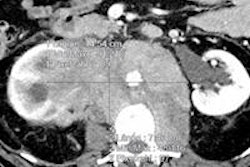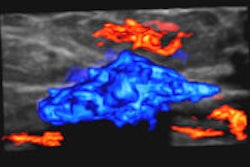In the second part of our series on implementing postprocessing requirements for radiologists and clinicians in the 3D laboratory, AuntMinnie.com provides Laura Pierce's suggestions for meeting the needs of clinicians. For part 1 on meeting the needs of radiologists, click here.
In evaluating clinician needs for 3D postprocessing, it's important to determine what is going to add value to their workflow, said Laura Pierce, administrative director of the Multidimensional Imaging Processing Laboratory at Duke University.
"We need to understand and predict what the clinicians will value, and sometimes we don't really realize that in radiology and as radiologists," Pierce said. She spoke on meeting customer needs for 3D postprocessing during a presentation at the recent International Symposium on Multidetector-Row CT in Washington, DC.
To listen to the "voice" of the clinician customers, firsthand knowledge is required of their expectations for CT postprocessing. To accomplish this goal, a Duke team performed interpretive research and in-person interviews with clinicians, Pierce said.
In a process that took about 21 months, the group performed 35 qualitative interviews with top referring physicians in their own offices. Each interview lasted approximately one hour and included both a facilitator and a scribe. The referring physicians received a declaration of exemption from further Institutional Review Board review in exchange for their participation.
The interviews generated 352 data points, or comments, from the referring physicians. These included 81 responses categorized as "facts" and 271 defined as "feelings." Facts were objective statements describing customer challenges, while feelings were emotional statements expressing customer feelings about the challenges.
"Your opportunities for improvement are identified through feelings," she said. "We felt very good about getting more feelings than facts; that meant that referring physicians felt very comfortable talking to us."
From those data points, the group formatted anonymized customer quotes into place cards and clustered them using the Jiro Kawakita affinity process. They were placed on five white boards; assigned to collective headers, or insights; and ranked from highest to lowest customer needs. Comments on each board were split into facts (needs) and feelings (wants) under 22 headers (insights).
The most important insight gained from the interviews was that referring clinicians said, "We need you to know us better," Pierce noted.
Understanding their needs
Customers want their needs understood, and radiology was perceived not to be fully engaged with the clinicians. One referring physician stated that "the radiologist creates 3D images only for cases they are interested in," Pierce said.
In addition, the referring physicians believed that reports are not designed around customer needs. Comments included the need to have some sort of schematic or key image to accompany the report, and a desire to have the images look more like what they are accustomed to seeing, such as in the operating room or when performing procedures, Pierce said.
They also mentioned a need for better communication, according to Pierce, and said that key details are often lost in the ordering process. They also wanted to improve communication with radiology.
"They said, 'It would really be great if we could continue that in-person communication from years past,' and proposed having a radiologist come to tumor boards to present to the larger audience our techniques and what we can offer," Pierce said. "In other words, they were saying that they really miss you; they really miss that face-to-face communication with you."
Another insight had to do with the time pressure being faced by referring physicians. Speed must be considered when measuring solutions to challenges, as customers are being driven by patient pressure, she said.
Guidance and key information
Customers also require education to make the most of 3D, as some reported that they're not getting the guidance they need from radiology, Pierce said.
The researchers also found that customers need key information. A significant number of anatomy-related needs were revealed in the interviews.
"They get kind of lost in the 3D imaging," she said. "They said that reports lack specific details about what they desire and need to see relationships with surrounding anatomy, and they also said there were a number of measurements not being provided by radiology."
Furthermore, customers wanted to review data in ways that are familiar to them, and they would like a simplified presentation of findings. They would really like to decrease their image workload, Pierce added.
"They don't want to look through all of our images," she said. "They really want us just to enrich the reports with a few images."
Some respondents mentioned they would also like to interact with the 3D tool, she said.
In addition, customers want to evaluate a case over time; longitudinal reporting was a common theme among interviewees. They would like prior comparisons with tables, graphs, and images, Pierce said.
"They want to see if any kind of treatment has an effect, and they would like having the ability to identify trends across multiple studies in sequence," she said. "They thought that would be a great tool to have."
Forward thinking
In another insight, customers want to remain progressive, Pierce said. They had a future-forward mindset and a desire to explore new areas of opportunity with radiology.
"They want radiology to reach out to other experts," she said. "They are seeing things at seminars like this, they are reading publications, they know what's possible out there, and they just want to be aware of techniques that are not currently being offered."
They would like radiology to be able to fuel modernization of other departments, as well as the chance to explore research opportunities with radiology.
Customers also want to do more with imaging; there was significant interest in greater leveraging of radiology's expertise and services, such as providing "more segmentation features that maybe fuse together different phases in the 3D imaging," Pierce said.
Interviewees also would like help in shaping preoperative planning with simulations to determine which modules are needed for surgical graft procedures, she said.
Outside images
Although the interviews focused on the emergency room and didn't necessarily deal with postprocessing, customers mentioned they wanted access to outside images before patients even arrive at the institution.
In addition, customers wished for more from vendor software tools, with interviewees pointing out several deficiencies.
For example, some surgeons have mentioned that including percentages on images actually creates more questions than answers, she said. Also, 3D tools don't effectively place the data in the medical record and, therefore, that information is worthless to them, Pierce said.
They would also like tools to give the operator flexibility to control what he or she wants measured.
Implementing customer ideas
To hear the voice of the clinician customers, meet with stakeholders, objectively rank and analyze ideas, and then vote for the top three groups to decide where to target your efforts, Pierce said. After implementing these customer ideas, it's crucial to follow up with referring physicians a year or two later.
"Technology keeps changing, and their needs will keep changing," she said.



















